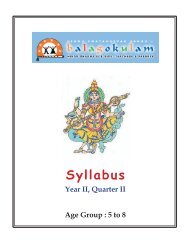Bauddhik Plan for Age Group 9-12 for the second ... - Balagokulam
Bauddhik Plan for Age Group 9-12 for the second ... - Balagokulam
Bauddhik Plan for Age Group 9-12 for the second ... - Balagokulam
Create successful ePaper yourself
Turn your PDF publications into a flip-book with our unique Google optimized e-Paper software.
AugustDharmaHoma (offering of oblations into <strong>the</strong> fire with sacred chants) signifies<strong>the</strong> offering or surrender of <strong>the</strong> ego and egocentric desires into <strong>the</strong> flame ofknowledge or a noble and selfless cause. The consequent ash signifies <strong>the</strong>purity of <strong>the</strong> mind, which results from such actions. Also <strong>the</strong> fire of knowledgeburns <strong>the</strong> oblation and wood signifying ignorance and inertia respectively.The ash we apply indicates that we should burn false identification with <strong>the</strong>body and become free of <strong>the</strong> limitations of birth and death. This is not tobe misconstrued as a morose reminder of death but as a powerful pointertowards <strong>the</strong> fact that time and tide wait <strong>for</strong> none.Bhasma is specially associated with Lord Shiva who applies it all over Hisbody. Shiva devotes apply bhasma as a tripundra (<strong>the</strong> <strong>for</strong>m of “º “). When appliedwith a red spot at <strong>the</strong> centre, <strong>the</strong> mark symbolises Shiva-Shakti (<strong>the</strong> unity ofenergy and matter that creates <strong>the</strong> entire seen and unseen universe).Bhasma has medicinal value and is used in many ayurvedic medicines.It absorbs excess moisture from <strong>the</strong> body and prevents colds and headaches.The Upanishads say that <strong>the</strong> famous Mrityunjaya mantra should be chantedwhilst applying ash on <strong>the</strong> <strong>for</strong>ehead.Tryambakam yajaamaheSugandhim pushtivardhanamUrvaarukamiva bhandhanaanMrytyor muksheeyamaa amrutaat“We worship <strong>the</strong> three-eyed Lord Shiva who nourishes and spreadfragrance in our lives. May He free us from <strong>the</strong> shackles of sorrow, change anddeath – ef<strong>for</strong>tlessly, like <strong>the</strong> fall of a ripe brinjal (eggplant) from its stem.”We will see few more hindu rituals in <strong>the</strong> following chapters.30Hindu Swayamsevak Sangh (HSS)
















